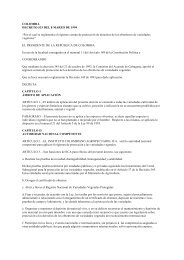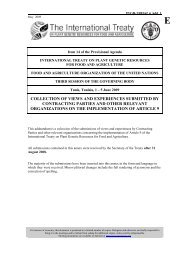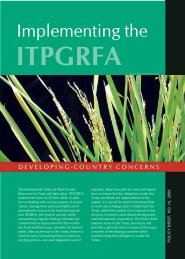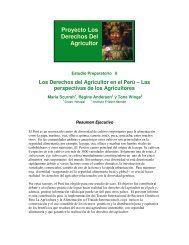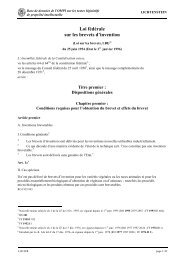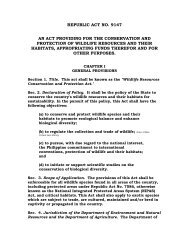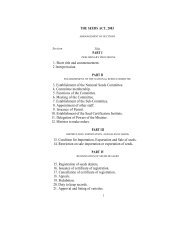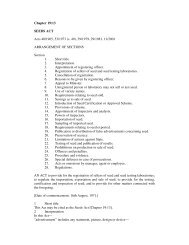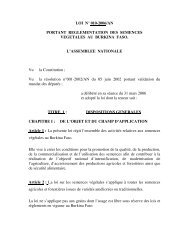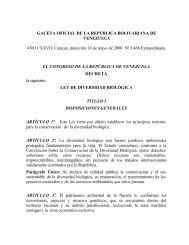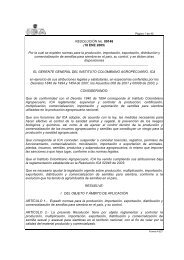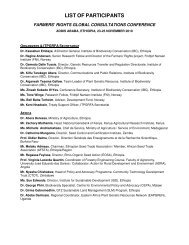Para PDF Tesis con Figuras en Word.p65 - Farmers' Rights website
Para PDF Tesis con Figuras en Word.p65 - Farmers' Rights website
Para PDF Tesis con Figuras en Word.p65 - Farmers' Rights website
You also want an ePaper? Increase the reach of your titles
YUMPU automatically turns print PDFs into web optimized ePapers that Google loves.
Till today Huancavelica is known as “La Villa Rica de Oroposa” (the rich town of mercury; see<br />
Salas Guevara, 1993). Huancavelica’s history as a mining c<strong>en</strong>ter from 1564 till 1786 repres<strong>en</strong>ts<br />
more than two c<strong>en</strong>turies of Indian exploitation and g<strong>en</strong>ocide. The mine had the highest mortality<br />
rate in the whole of Latin America because of the toxicity of mercury and inhumane working<br />
<strong>con</strong>ditions (Brown, 2001; Whitaker, 1941). The Spanish elite recruited its workforce by forcing<br />
local Indians to work. Indians were “recruited” on the countryside, chained and put to work as<br />
slaves at a time wh<strong>en</strong> the region had already be<strong>en</strong> affected by demographic collapse as a<br />
<strong>con</strong>sequ<strong>en</strong>ce of disease (Cook, 1981).<br />
After the closure of the Santa Barbara mine the fate of Huancavelica´s indig<strong>en</strong>ous population<br />
<strong>con</strong>tinued to be plagued with oppression. Most of its territory was managed by large haci<strong>en</strong>das<br />
belonging to the colonial and mestizo elite (Carrasco, 2003; Favre, 1976; Sabogal, 1952). The local<br />
population had to work for the haci<strong>en</strong>das and had limited access to land to sustain their own<br />
minimal needs for food. This situation only changed as rec<strong>en</strong>tly as 1969 wh<strong>en</strong> the leftwing military<br />
governm<strong>en</strong>t of Juan Francisco Velasco Alvarado initiated a national agrarian reform program<br />
<strong>con</strong>verting the haci<strong>en</strong>das into state run cooperatives (Guillet, 1974, 1979; Long and Roberts,<br />
1979; Piel, 1995). Most of the cooperatives disintegrated during the 1980´s leading to the<br />
redistribution of land to farmer communities in Huancavelica. The process of regained autonomy<br />
of farmer communities over their territory coincided with an upsurge in rural viol<strong>en</strong>ce wh<strong>en</strong><br />
the Shining Path (S<strong>en</strong>dero Luminoso), a Maoist inspired guerilla movem<strong>en</strong>t, largely took <strong>con</strong>trol<br />
of the departm<strong>en</strong>t of Huancavelica (Stern, 1998). Betwe<strong>en</strong> 1981 and 1992 Huancavelica was closed<br />
off from the outside world. Being declared an emerg<strong>en</strong>cy zone, its largely indig<strong>en</strong>ous population<br />
was subject to human rights violations from both the Peruvian army and the Shining Path<br />
resulting in the death and displacem<strong>en</strong>t of thousands of people (CVR, 2003; Scott Palmer, 1994).<br />
Only since 1995 has relative calm returned to Huancavelica´s countryside.<br />
1.5.2 Pres<strong>en</strong>t situation<br />
Huancavelica is one of Peru’s 24 departm<strong>en</strong>ts and is located in the c<strong>en</strong>tral Andes surrounded by<br />
the departm<strong>en</strong>ts of Ayacucho (south), Ica (west), Lima (north-west) and Junín (north, north-east).<br />
Politically the departm<strong>en</strong>t is subdivided into 7 provinces, 94 districts and over 500 farmer<br />
communities. The departm<strong>en</strong>t covers an area of 22,131 km², repres<strong>en</strong>ting 6.1% of the total land<br />
area covered by the Peruvian Andes. Huancavelica is inhabited by 447,055 inhabitants; this<br />
repres<strong>en</strong>ts an overall population d<strong>en</strong>sity of 20.2 persons per km² (INEI, 2005). About 80% of<br />
Huancavelica’s territory is located betwe<strong>en</strong> 3,000 and 4,500 m above sea level and 73.9% of its<br />
population lives in the countryside (Rubina and Barreda, 2000). Poverty rates in Huancavelica<br />
are the highest in Peru (Luna Amancio, 2008; MEF, 2001). In 2001, 74.4% of the total population<br />
was <strong>con</strong>sidered to be extremely poor (INEI, 2002). Chronic malnutrition (stunting) affects more<br />
than 50% of childr<strong>en</strong> under 5 years of age while acute malnutrition affects slightly less than 1%<br />
(INEI, 1996, 2000).<br />
A total of 86,003 individual farm units in Huancavelica dep<strong>en</strong>d on agriculture as its main<br />
e<strong>con</strong>omic activity (Rubina and Barreda, 2000). Smallholder farming systems in the departm<strong>en</strong>t<br />
are typically mixed, integrating both livestock and crop husbandry (Ossio and Medina, 1985).<br />
Most communities maintain communal landholdings for cropping or as pasture land. Average<br />
land holdings fluctuate betwe<strong>en</strong> 0.5 and 3.5 hectares per household (Alfaro et al., 1997). Potato<br />
is the principal crop and annually occupies approximately 27% of the total cultivated area<br />
followed in importance by barley, wheat, maize, fababeans and peas (Rubina and Barreda, 2000).<br />
Mixed livestock populations kept by smallholder farmers in Huancavelica include alpacas, lamas,<br />
guinea pigs, cows, sheep and pigs.<br />
1.5.3 Research communities<br />
Field research was <strong>con</strong>ducted in 8 farmer communities following a north-south transect through<br />
30 Potato diversity at height: Multiple dim<strong>en</strong>sions of farmer-driv<strong>en</strong> in-situ <strong>con</strong>servation in the Andes



